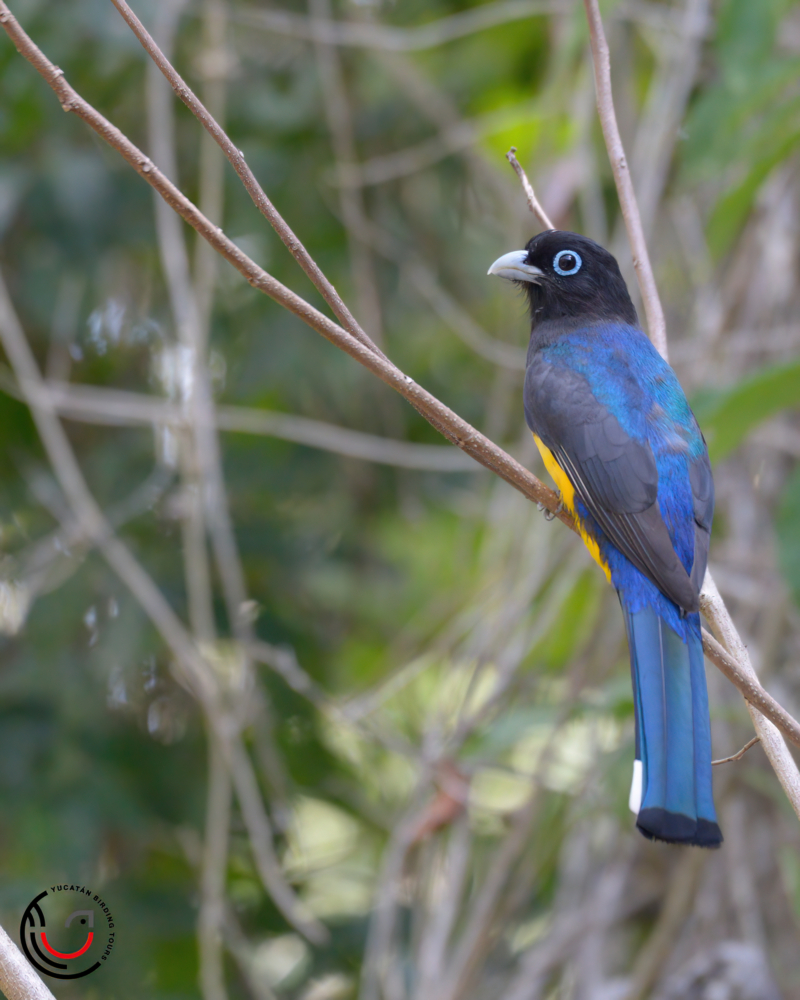8-day Birding Tour, March 2024
This 8-day birding tour started on March 10th, when I picked up Dave and Gina in Playa del Carmen. There were three goals for this birding tour, set by Dave months ago when we were planning this trip:
1.- To see more than 200 species.
2.- Getting as many warbler species as possible.
3.- Getting the Yucatan Endemics.
Day 1.
Our visitors from the UK and I took the road and drove all the way to Rio Lagartos where our captain "Chino Carbon" was waiting for us to do a boat ride in the afternoon. Before heading into the mangroves of the reserve, we made a stop to get lunch with a water view. There, we picked up our first Wood Stork, Sandwich Tern, Royal Tern, Laughing Gull, Magnificent Frigatebird, American White Pelican Brown Pelican and of course, Great-tailed Grackles.
After a good meal, we met Chino near our hotel “Villa de Pescadores” and took the boat ride. We saw more than 52 bird species while exploring the mangroves and estuaries of Rio Lagartos. Some of the highlights include: Black-bellied Whistling-Duck, Red-breasted Merganser, American Flamingo, Black-bellied Plover, Semipalmated Plover, Wilson’s Plover, Marbled Godwit, Short-billed Dowitcher, Spotted Sandpiper, Willet, Greater Yellowlegs, Ruddy Turnstone, Sanderling, Western Sandpiper, Lesser Black-backed Gull, Black Skimmer, Least Tern, Gull-billed Tern, Caspian Tern, Black Tern, Forster’s Tern, Anhinga, Bare-throated Tiger-Heron, Yellow-crowned Night Heron, Reddish Egret, Great Blue Heron (Great White), Roseate Spoonbill, Common Black Hawk and Tree Swallow.
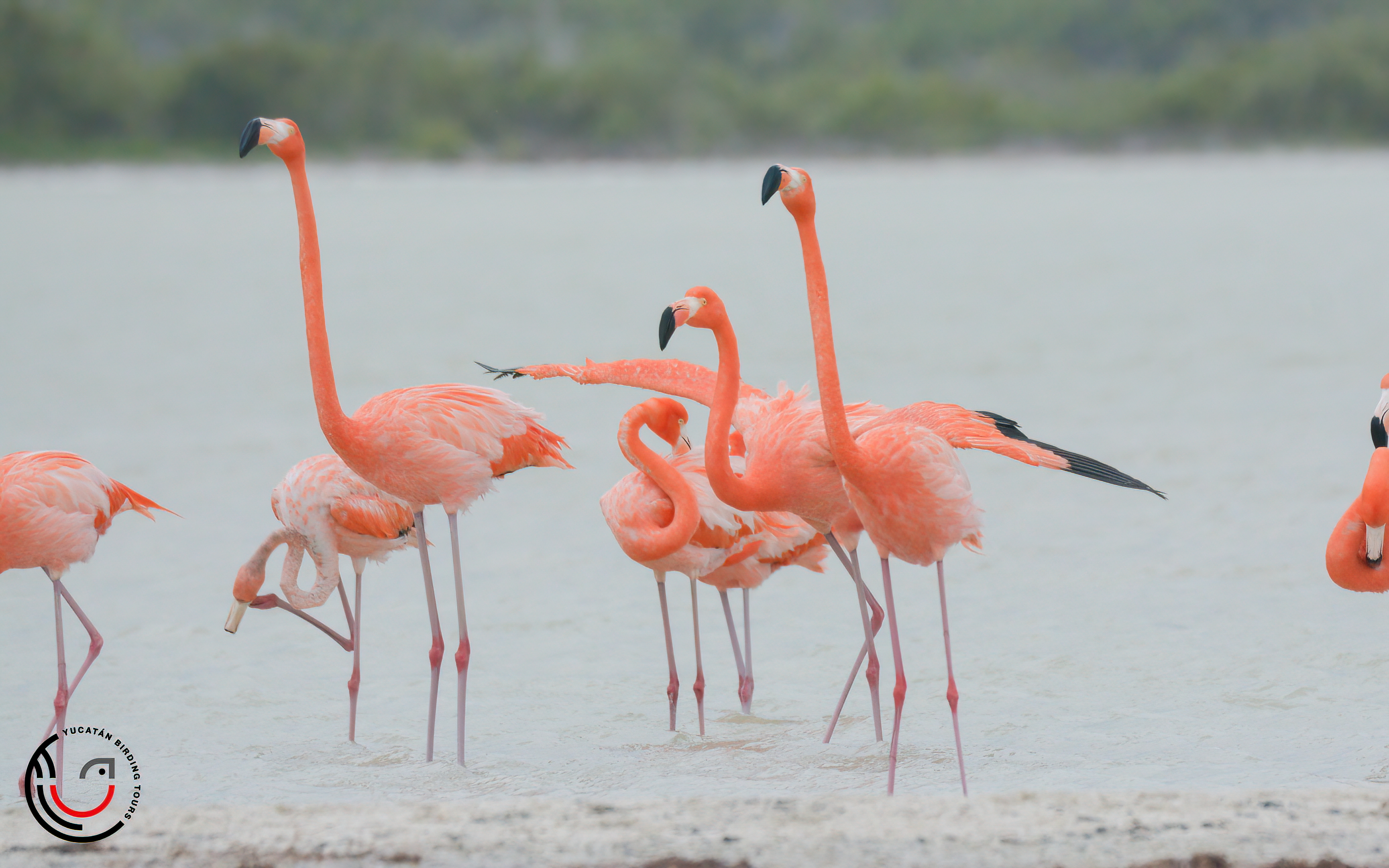
American Flamingo (Phoenicopterus ruber) in Rio Lagartos.
Then, we waited for the daylight to go away and tried for the Yucatan Nightjar with complete success.

Yucatan Nightjar (Antrostomus badius) seen from our boat in Rio Lagartos.
Day 2.
For day two, we had planned a morning birding the Rio Lagartos’ area. We started by visiting the San Salvador Road, one of the reserves’ top birding spots. It didn’t disappoint as we were able to see and hear around 76 species. Some of the top birds included: Common Ground Dove, Ruddy Ground Dove, Smooth-billed Ani (a third record for the state!), Groove-billed Ani, Mexican Sheartail, Canivet’s Emerald, Cinnamon Hummingbird, Common Gallinule, Northern Jacana, Solitary Sandpiper, Wood Stork, Roseate Spoonbill, Boat-billed Heron, Least Bittern, Little Blue Heron, Lesser Yellow-headed Vulture, Swallow-tailed Kite, Crane Hawk, Crested Caracara, White-fronted Amazon, Olive-throated Parakeet, Barred Antshrike, Rose-throated Becard, Mangrove Vireo, Yucatan Jay, Yucatan Wren, Orange Oriole, Northern Waterthrush, Common Yellowthroat, Northern Parula, Magnolia Warbler, Yellow Warbler, Northern Cardinal, Painted Bunting, Blue-black Grassquit, Morelet’s Seedeater, Yellow-faced Grassquit and Cinnamon-bellied Saltator.

Northern Cardinal (Cardinalis cardinalis) on the San Salvador Road.
After a wonderful morning with lots of birds, we went back to our hotel for a good breakfast and then to check a few boardwalks in the area. On the first boardwalk, we were able to spot a Common Black Hawk, Tropical Kingbirds, Green Jays and Melodious Blackbirds.
On the way to the second one, we spotted a juvenile Gray Hawk. Then, on the boardwalk we spotted another Crane Hawk, Yellow-crowned Night Heron, Tricolored Heron, Green Heron and the icing on the cake, an American Pygmy Kingfisher.
After birding Rio Lagartos, we headed to Valladolid. We dropped our stuff at the hotel and then went to visit one of the top birding spots in the Yucatan Peninsula. The Xocen Birding Trail. That day, the local guides weren't able to go with us, but we still supported the local community by paying entrance fees. After spending about 2 hours birding in the evening there, we spotted quite a few good birds including: Canivet’s Emerald, Buff-bellied Hummingbird, Ferruginous Pygmy-Owl, Turquoise-browed Motmot, Yucatan Woodpecker, Golden-olive Woodpecker, White-fronted Amazon, Yellow-lored Amazon, Olivaceous Woodcreeper, Ivory-billed Woodcreeper, Masked Tityra, Northern Bentbill, Northern Tropical Pewee, Rufous-browed Peppershrike, Brown Jay, Green Jay, Yucatan Jay, Scrub Euphonia, Yellow-billed Cacique, Orange Oriole, Black-and-white Warbler, Common Yellowthroat, Magnolia Warbler, Black-throated Green Warbler, Red-throated Ant-Tanager, Gray-throated Chat, Blue Bunting, Indigo Bunting and Black-headed Saltator.

Gray-throated Chat (Granatellus sallaei) at the Xocen Birding Trail.
We waited until it got dark to try for nightbirds, we got Common Pauraque, Yucatan Poorwill and Yucatan Nightjar.
Day 3.
For our third day birding together, we decided to visit the Cobá Archaeological Site to increase our chances of spotting the Ocellated Turkey, one of the only two Turkey species in the world. With all of the chaos on the roads and ruins in the Mayan Train route, it was best to visit this place as it was closer to Valladolid and far from the crazy and dangerous driving.
Before actually entering the ruins, we birded the lagoon just outside, were we spotted almost 50 bird species including: Plain Chachalaca, Ruddy Ground Dove, Vaux’s Swift, Cinnamon Hummingbird, Purple Gallinule, Limpkin, Northern Jacana, Pied-billed Grebe, Anhinga, Little Blue Heron, Osprey, Turquoise-browed Motmot, Belted Kingfisher, White-fronted Amazon, Yellow-bellied Elaenia, Social Flycatcher, Tropical Kingbird, Couch’s Kingbird, Tree Swallow, Purple Martin, Cave Swallow, Clay-colored Thrush, Orchard Oriole, Hooded Oriole, Northern Parula, Yellow Warbler, Yellow-rumped Warbler, Yellow-throated Warbler, Yellow-winged Tanager, Morelet’s Seedeater and Cinnamon-bellied Saltator.
After about an hour of birding outside, we went into the ruins to try for Ocellated Turkey. It tooks us a while to find it as sometimes they’re completely out in the open, sometimes they’re not. So, after sitting patiently, there it was, the first Ocellated Turkey of the morning walking towards us! Besides the Turkeys, we also spotted quite a few good birds like White-bellied Emerald, Roadside Hawk, Gray Hawk, Black-headed Trogon, Gartered Trogon, Lesson’s Motmot, Keel-billed Toucan, Pale-billed Woodpecker, Lineated Woodpecker, Olive-throated Parakeet, Olivaceous Woodcreeper, Ruddy Woodcreeper, Tawny-winged Woodcreeper, Northern Barred Woodcreeper, Ivory-billed Woodcreeper, Masked Tityra, Rose-throated Becard, Northern Bentbill, Eye-ringed Flatbill, Yellow-olive Flatbill, Great Crested Flycatcher, Piratic Flycatcher, Lesser Greenlet, Brown Jay, Yellow-throated Euphonia, Yellow-backed Oriole, Altamira Oriole, Ovenbird, Lousiana Waterthrush, Hooded Warbler, Summer Tanager, Red-throated Ant-Tanager and Black-headed Saltator.

Cellphone picture of Ocellated Turkey (Meleagris ocellata) at the Cobá Archaeological Site.
After birding Cobá, we went all the way to Bacalar, where we did a relaxed evening birding outside the hotel grounds at the Bacalar B7 Blue. After hour and a half of birding, we spotted 40+ bird species. Some of the highlights included: Scaled Pigeon, Red-billed Pigeon, Buff-bellied Hummingbird, White-bellied Emerald, Coopers Hawk (a very rare species for the area!), Short-tailed Hawk, Ferruginous Pygmy-Owl, Black-headed Trogon, Collared Aracari, Lineated Woodpecker, Yellow-lored Amazon, Olive-throated Parakeet, Rose-throated Becard, Bright-rumped Attila, Boat-billed Flycatcher, Lesser Greenlet, Yucatan Jay, Gray-breasted Martin, Long-billed Gnatwren, Black-cowled Oriole, Prothonotary Warbler, Red-throated Ant-Tanager, Yellow-faced Grassquit and Black-headed Saltator.
Day 4.
On the fourth day of the tour, we planned a visit to the Kohunlich Archaeological Site, a wonderful place south in the Yucatan Peninsula, filled with well-preserved forests, huge palm trees and lots of wildlife.
Even before, hitting the main road to the ruins, we were already spotting really good birds like an adult Gray-headed Kite, Yellow-bellied Eleanias, Mangrove Vireo and both Black-headed Saltator and Cinnamon-bellied Saltator.
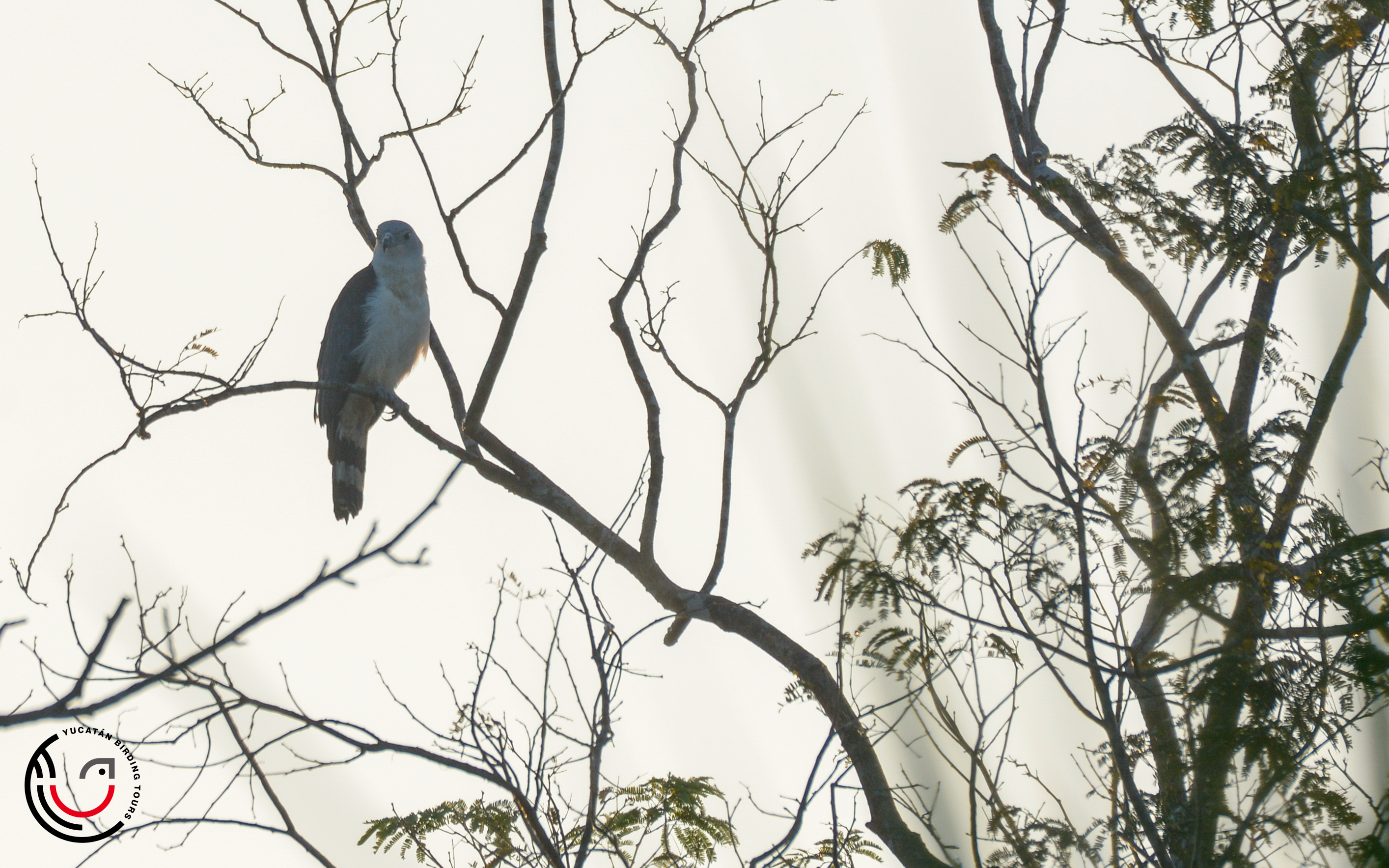
Gray-headed Kite (Leptodon cayennensis) near the Kohunlich Archaeological Site.
Once we got to a spot that’s pretty much a seasonal pool inside the forest, we stopped and started walking around looking for birds. Some of the highlights included: Wedge-tailed Sabrewing, Rufous-tailed Hummingbird, White-bellied Emerald, Black-headed Trogon, Keel-billed Toucan, White-crowned Parrot, White-collared Manakin, Bright-rumped Attila, Lesser Greenlet, Yellow-throated Euphonia, Green-backed Sparrow, American Redstart and Gray-headed Tanager.
Once inside the ruins, we were greeted by a pair of Squirrel Cuckoos that were hunting for caterpillars, checking every leaf on the trees and jumping like squirrels do!
We spent 2 hours birding the ruins and spotted 45 bird species, including: Scaled Pigeon, Rufous-tailed Hummingbird, Keel-billed Toucan, Bat Falcon, White-crowned Parrot, Olive-throated Parakeet, Red-capped Manakin, Masked Tityra, Ochre-bellied Flycatcher, Yellow-olive Flatbill, Northern Beardless-Tyrannulet, Greenish Elaenia, Yellow-bellied Flycatcher, White-eyed Virel, Yellow-throated Vireo, Red-crowned Ant-Tanager, Rose-breasted Grosbeak and Indigo Bunting.
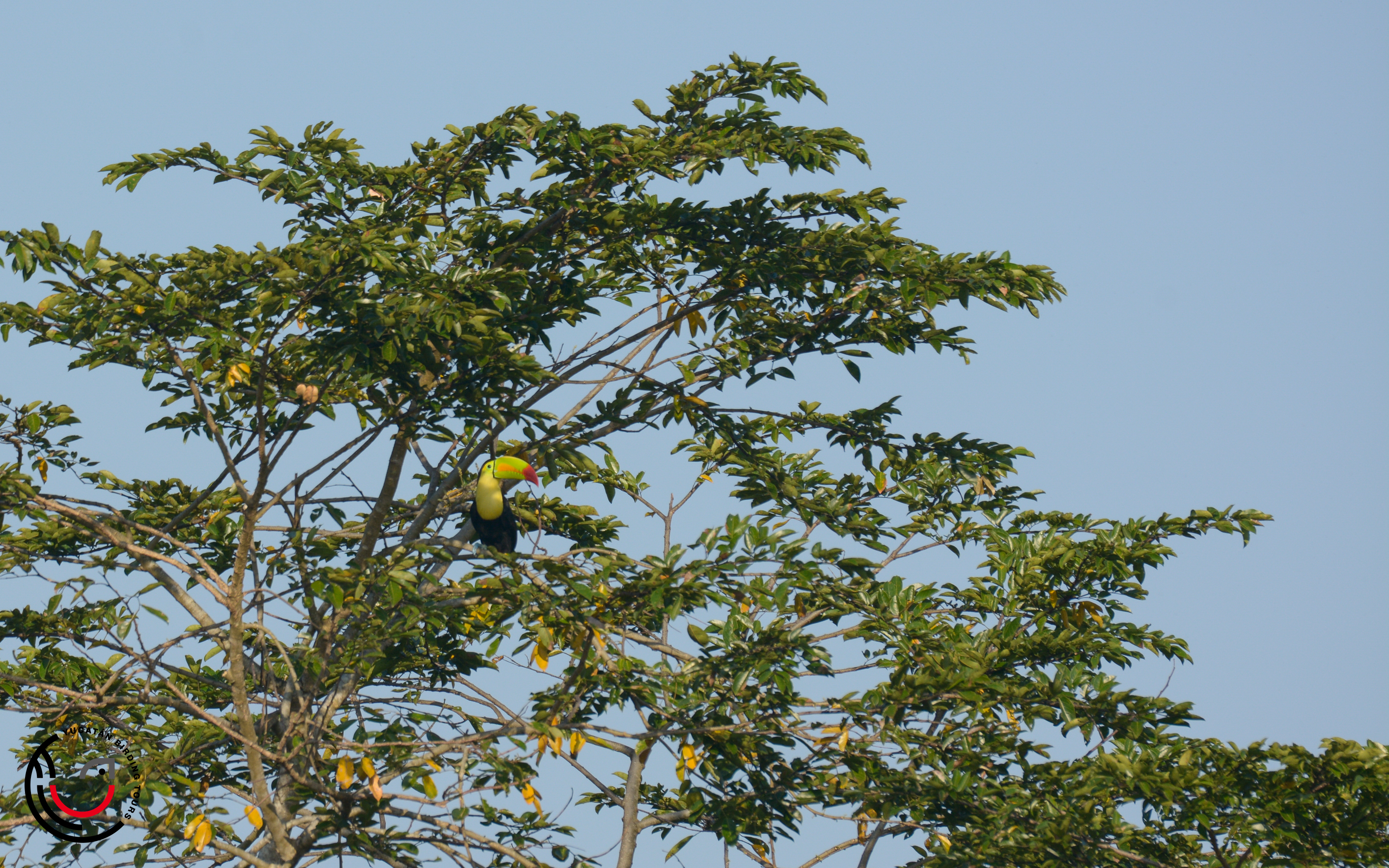
Keel-billed Toucan (Ramphastos sulfuratus) at the Kohunlich Archaeological Site.
Then, for the evening birding, we repeated the trail outside the hotel grounds in Bacalar, where we spent a little bit more than hour and half birding and spotted 47 species. Some highlights included: Red-billed Pigeon, Groove-billed Ani, Rufous-tailed Hummingbird, White-bellied Emerald, Caspian Tern, Royal Tern, Black-headed Trogon, Gartered Trogon, Rose-throated Becard, Dusky-capped Flycatcher, Rufous-browed Peppershrike, Gray-breasted Martin, Black-cowled Oriole, Hooded Oriole, Altamira Oriole, Magnolia Warbler, Yellow Warbler, Black-throated Green Warbler and Summer Tanager.
Then, inside the Hotel Grounds (which are right in front of the seven-color lagoon) we found a Lesser Scaup that was feeding on Apple Snails! We also spotted a Limpkin, Neotropic Cormorants, Snail Kites, Great Kiskadees and Yellow-winged Tanagers.
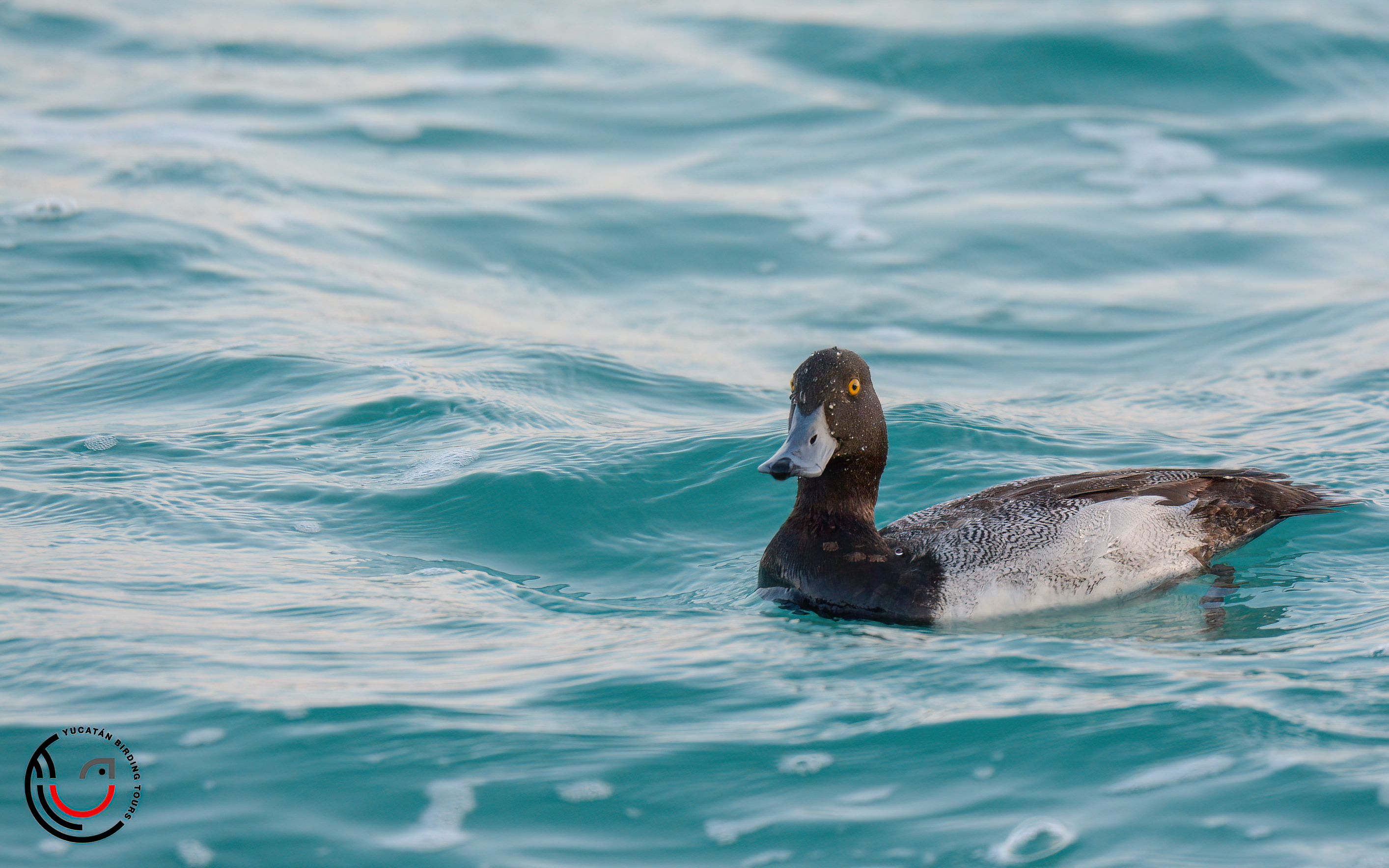
Lesser Scaup (Aythya affinis) at the Bacalar B7 Blue Apartments.
Day 5.
The next day the plan was to visit the “Siijil Noh Ha” reserve, which was about an hour driving north from Bacalar. Before that, we made a quick stop at a lagoon to try for Ringed Kingfisher with success! We also spotted other nice birds like Purple Gallinule, Northern Jacana, Neotropic Cormorant, Belted Kingfisher, Green Kingfisher, Yellow-bellied Elaenia, Brown-crested Flycatcher, Mangrove Swallow, Southern House Wren, Orchard Oriole, Hooded Oriole and Blue-black Grassquit.
Then, as we kept driving towards the Siijil Noh Ha reserve, we made a stop at the “Reserva Ejidal Much Kanan K’aax” for more forest birding. We came across a patch of activity where we were able to spot many birds without moving. Some of the highlights include: Roadside Hawk, Black-headed Trogon, Keel-billed Toucan, Masked Tityra, Brown Jay, White-browed Gnatcatcher, Yellow-throated Euphonia, American Redstart, Rose-throated Tanager, Red-throated Ant-Tanager, Gray-throated Chat and Red-legged Honeycreeper.

Red-legged Honeycreeper (Cyanerpes cyaneus) near the "Siijil Noh Ha" Reserve.
Once we finally got to the Siijil Noh Reserve, it was very windy and too quiet but we still managed to see some good birds like Black-headed Trogon, Yucatan Woodpecker, Yellow-olive Flatbill, Lesser Greenlet, White-eyed Vireo, Mangrove Swallow, White-browed Gnatcatcher, Red-winged Blackbird, Hooded Warbler, Magnolia Warbler and Black-headed Saltator.

Yucatan Woodpecker (Melanerpes pygmaeus) at the Siijil Noh Ha Reserve.
After birding some of the best spots in Felipe Carrillo Puerto for the morning, we left and drove all the way to Mérida. Before finishing a very long day of driving, we went to one of Merida’s ecological parks, where there was a roosting Northern Potoo. Highlights from the park include: Blue-winged Teal, Ruddy Ground Dove, Groove-billed Ani, Northern Potoo, Ruby-throated Hummingbird, Cinnamon Hummingbird, Common Gallinule, Black-necked Stilt, Solitary Sandpiper, Greater Yellowlegs, Least Sandpiper, Least Grebe, Little Blue Heron, Snowy Egret, Green Heron, Great Egret, Great Blue Heron, Blue-gray Gnatcatcher, Blue-gray Tanager and Cinnamon-bellied Saltator.
Day 6.
On our sixth day, we visited one of Mérida’s top birding hotspots, the Misnebalam Road, a combination of ranches and dry forest which produces a lot of birds like raptors, orioles, flycatchers and more! After spending hour and a half here we got 50+ species, including: Plain Chachalaca, Black-throated Bobwhite, Common Ground Dove, Lesser Roadrunner, Squirrel Cuckoo, Great Black Hawk, Turquoise-browed Motmot, Ladder-backed Woodpecker, American Kestrel, Rose-throated Becard, Yucatan Flycatcher, Dusky-capped Flycatcher, Great Kiskadee, Rufous-browed Peppershrike, White-eyed Vireo, Mangrove Vireo, Green Jay, Yucatan Jay, Yucatan Gnatcatcher, Olive Sparrow, Lark Sparrow, Orange Oriole, Bronzed Cowbird, Gray-crowned Yellowthroat, Northern Cardinal, Rose-breasted Grosbeak. Indigo Bunting and Painted Bunting.

Orange Oriole (Icterus auratus) on the Misnebalam Road.
After that, we moved to the coast, to a road that goes across a swampy area with mangrove trees. There we spotted again, 50+ species. Highlights included: Blue-winged Teal, Squirrel Cuckoo, Vaux’s Swift, American Avocet, Semipalmated Plover, Short-billed Dowitcher, Willet, Laughing Gull, American Flamingo, Wood Stork, Magnificent Frigatebird, Double-crested Cormorant, Neotropic Cormorant, White Ibis, Tricolored Heron, Reddish Egret, American White Pelican, Brown Pelican, Common Tody-Flycatcher, Yucatan Gnatcatcher, Yellow-tailed Oriole, Red-winged Blackbird, Northern Waterthrush and Cinnamon-bellied Saltator.

Common Tody-Flycatcher (Todirostrum cinereum) in Progreso.
Then, we visited the Acuaparque in Mérida, another ecological park that used to be a quarry, now turned into a big hole with water, lots of aquatic plants, apple snails, introduced fish and turtle species, a bird’s paradise! Highlights from Acuaparque included: Vaux’s Swift, Common Gallinule, American Coot, Limpkin, Northern Jacana, Solitary Sandpiper, Least Grebe, Pied-billed Grebe, Anhinga, Double-crested Cormorant, Neotropic Cormorant, Black Vulture, Snail Kite, Gray Hawk, Blue-gray Gnatcatcher, Orchard Oriole, Yellow-throated Warbler and Blue-gray Tanager.
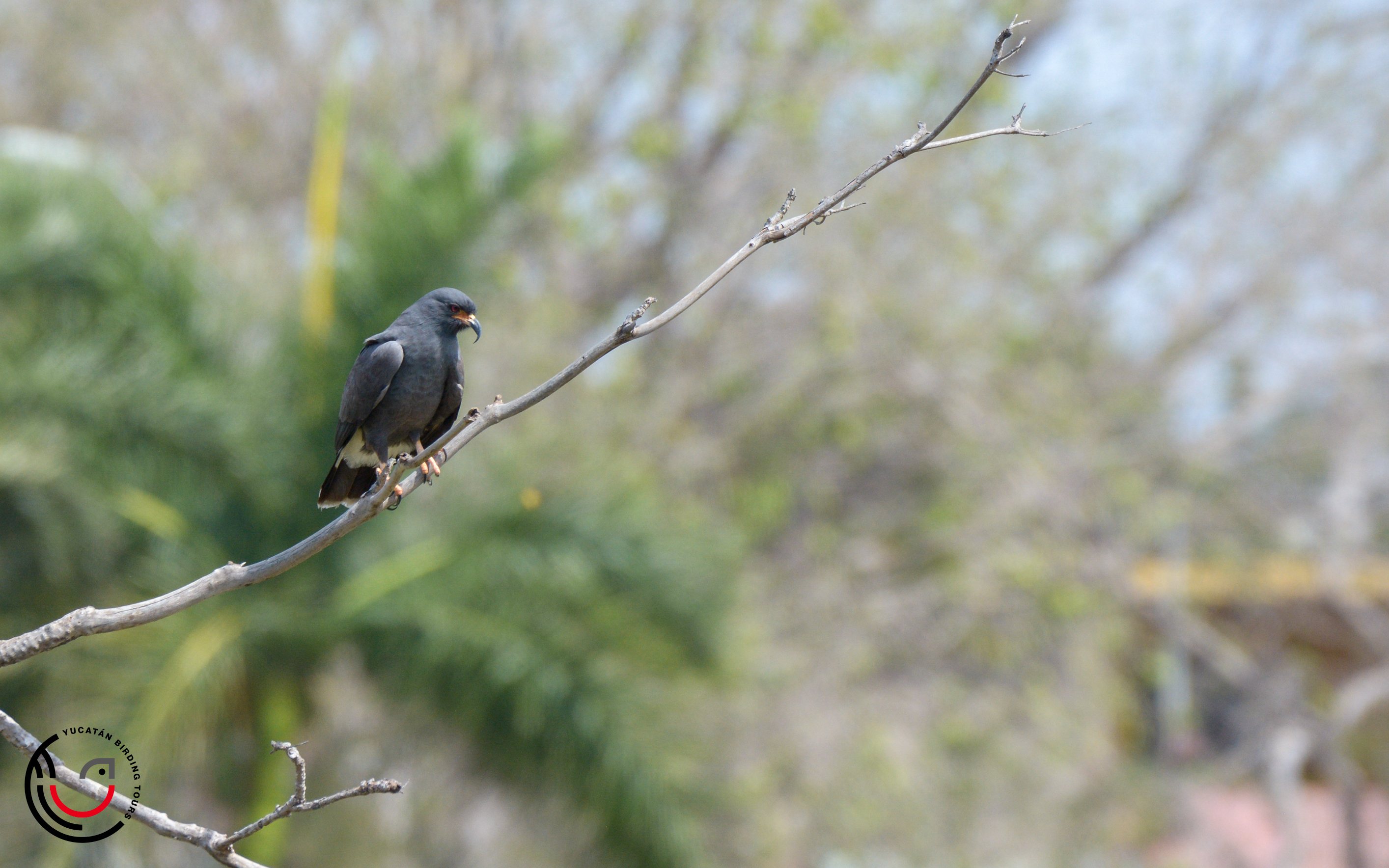
Snail Kite (Rostrhamus sociabilis) at Acuaparque.
In the evening, we went to Sisal, a place in the coast, where we tried for an Agami Heron and Sungrebe that had been reported a few days before. Unfortunately, we didn’t spot any of the two rarities for the area. Anyways, we still managed to see some cool birds like: Black-throated Bobwhite, Mexican Sheartail, Yucatan Jay, Yucatan Wren, Black-necked Stilt, Spotted Sandpiper, American Flamingo, Wood Stork, Anhinga, Yellow-crowned Night-Heron, Belted Kingfisher, Green Kingfisher, American Pygmy Kingfisher, Tropical Mockingbird, Northern Waterthrush, American Redstart, Northern Parula, Magnolia Warbler and Mangrove Warbler.
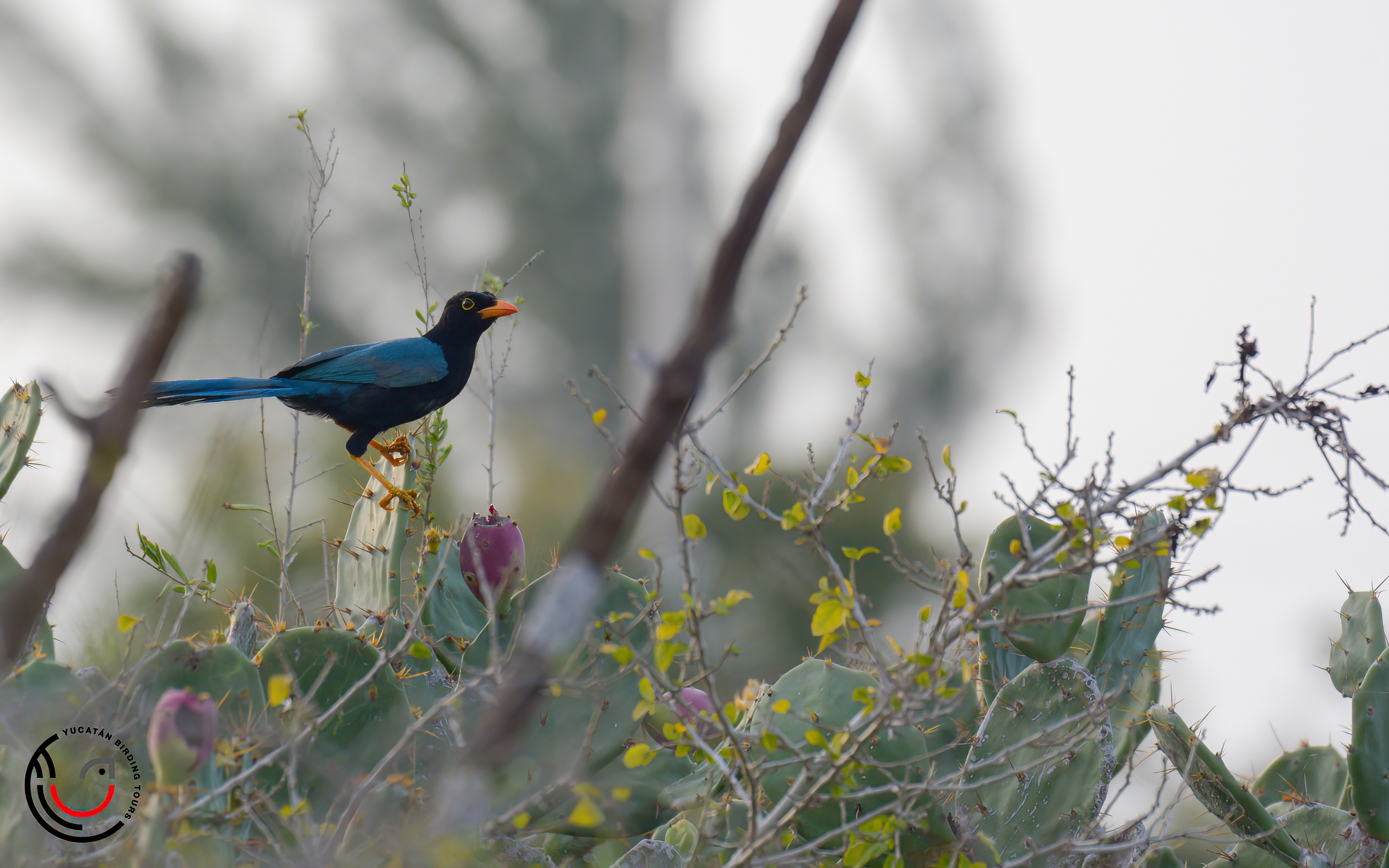
Yucatan Jay (Cyanocorax yucatanicus) in Sisal.
Day 7.
The seventh day of the tour was pretty much a transporation day, but since we were going to pass near the place, we decided to make a stop at the Tzucmuc road near the Amazili Nature Reserve for a morning of birding. We spotted almost 70 species in the area and our highlights included: Plain Chachalaca, Red-billed Pigeon, Common Ground Dove, Ruby-throated Hummingbird, Canivet’s Emerald, Buff-bellied Hummingbird, White-bellied Emerald, Turkey Vulture, Roadside Hawk, Gartered Trogon, Ladder-backed Woodpecker, Lineated Woodpecker, White-fronted Amazon, Yellow-lored Amazon, Northern Tropical Pewee, Bright-rumped Attila, Yucatan Flycatcher, Dusky-capped Flycatcher, Social Flycatcher, Brown Jay, Green Jay, Yucatan Jay, Olive Sparrow, Yellow-billed Cacique, Hooded Orioe, Yellow-tailed Oriole, Altamira Oriole, Melodious Blackbird, Gray-throated Chat, Blue Bunting, Indigo Bunting, Blue-black Grassquit and Yellow-faced Grassquit.

Bright-rumped Attila (Attila spadiceus) a very skulky bird!
We arrived in Playa del Carmen and rested the day so the next morning we could visit Cozumel Island.
Day 8.
For the last day, we took the earliest ferry to Cozumel Island, where our local guide Elvis Jimenez was waiting for us to take us birding and looking for the Cozumel endemics. On a very short morning birding in the island, we managed to see all of the endemics plus other endemic subspecies and migratory birds.
Highlights from our last morning birding together in Cozumel included: White-crowned Pigeon, Caribbean Dove, Osprey (Caribbean), Cozumel Emerald, Green-breasted Mango, Roseate Spoonbill, Yellow-bellied Sapsucker, Yucatan Woodpecker, Caribbean Elaenia, Brown-crested Flycatcher, Cozumel Vireo, Yucatan Vireo, Blue-gray Gnatcatcher, Cozumel Wren, Black Catbird, Gray Catbird, Yellow Warbler (Golden), Western Spindalis, Bananaquit and Yellow-faced Grassquit.

Golden Warbler (Setophaga petechia rufivertex) a Cozumel Island endemic.
This represented the end of our trip as Dave and Gina had a couple extra days in Playa del Carmen for a relaxed vacation and I would head back home to Mérida.
We finished the trip having accomplished all of David’s goals for the trip:
- We saw more than 200 species.
- Got many warbler species.
- Got the Yucatan Endemics.
Written by Luis Trinchan.





